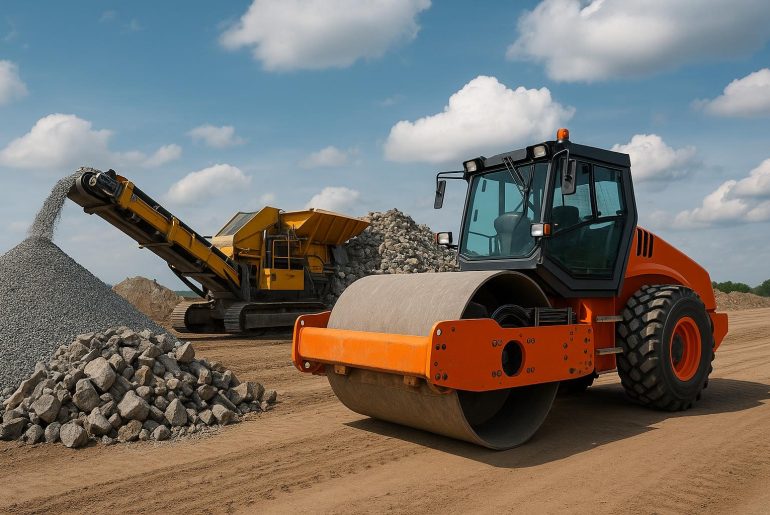Accordingly, road construction is a chain of mechanical transformations: reduction of raw material into specified gradations, laying as layers, and compacting to attain design strength and durability. In this analysis, sequential dominance flows through the major patterns in crushing and compaction operations and discusses machine families in light of function, mechanism, controllability, and suitability for different site conditions. The approach here starts at the gate of the plant, with the stone crusher setting parameters for the processes downstream, moves through feed and gradation control, and ends with layer-by-layer rolling strategies at the field site.
Sequential Pattern: Reduction of Material → Sorting → Placement → Dynamic Compaction
The pattern is dominantly linear but tightly coupled: every stage is constraining the next. Crushing produces particle size distribution and shape characteristics that prescribe workability and compaction energy, screening and stockpiling maintain lot traceability, haulage and placement control thermal and moisture states, and compaction converts a loose matrix into a load-bearing structure. Operations that work well treat the chain as a controlled pipeline: specify target in-place gradation and back-calculate crusher set points, feed rates, and screening cut points to minimize field adjustments.
Crushers – Their Mechanisms, Outputs, and Control Variables
Crushing machines fall into compressive and impact classes. Various types of compressive devices – including but not limited to- jaw, gyratory, cone- utilise a mechanism best defined by particle pressure, which leads to predictable reduction ratios. The best machines to invest in are well-equipped HSI and VSI machines. Critical control variables are feed size and distribution, closed-side setting (CSS) or gap setting, eccentric throw or rotor configuration, and feed rate stability.
Operational sequences in a plant typically run: primary reduction to nominal top size, secondary shaping to adjust particle form and fines, tertiary refining to meet gradation tolerances. Each stage must be balanced for throughput – surge hoppers and feeders buffer variability. Wear part condition and liner selection materially affect output gradation and must be included in process controls. Quality control relies on frequent sieve analysis at predetermined intervals and adjustment of crusher settings in response to measured deviations.
From Plant Gradation to Field Compaction – The Transfer Function
The “transfer function” linking plant gradation to in-place density is deterministic in principle but stochastic in practice. Particle size distribution, angularity, and proportion of fines set required compaction energy and roller type. Coarser, open-graded aggregates achieve interlock with less binder but require higher dynamic energy to close voids. Conversely, mixes with higher fines compact readily but are more sensitive to moisture and compaction speed. Managing this transfer requires two interventions:
(1) optimizing crushing to produce the target PSD at source, and
(2) sequencing placement and rolling to exploit the material’s mechanical response as temperature and moisture change.
Mid-Sequence Machine: Role and Selection Criteria
At mid-process, the primary reduction unit frequently encountered is the jaw crusher. Its reciprocating compression action is optimal for initial size reduction of large material and for handling heterogeneous feeds, including reinforced reclaimed material. Key selection criteria are gape size (dictates maximum feed), throughput capacity, reduction ratio, toggle strength, and ease of maintenance. In sequence planning, the jaw crusher’s predictable output allows downstream cone or impact crushers to focus on particle shape rather than bulk size reduction, improving overall plant efficiency and minimizing recirculation loads.
Compaction Sequences: Energy, Frequency, and Pass Patterns
Compaction is executed in staged energy increments: breakdown, intermediate, and finish. Breakdown rollers apply high-amplitude vibration to achieve initial particle rearrangement; intermediate passes continue densification and reduce surface irregularities; finish passes correct texture and seal the surface. Roller dynamics are characterized by static linear load, dynamic amplitude, frequency, and operational speed – all of which must be matched to lift thickness, aggregate stiffness, and temperature (for bituminous pavements).
The selection of the right kind of roller is based on the function of the layer and material, including smooth drum vibratory rollers, pneumatic-tyred rollers, and padfoot rollers. Intelligent compaction sensors have changed the way sequence management works because they allow for spatial stiffness maps and pass-count metrics, which can help reduce redundant passes and give uniform coverage.
Crushers and Compactors: An Optimization of Sequence
Crushers affect upstream variability; compactors use energy to make up for residual packing inefficiencies. Optimization biases the sequence toward upfront correction-adjusting crusher settings and screening-relatively than downstream remediation-extra roller passes. Comparative assessment metrics should include tons per hour meeting target PSD, number of failed density spots per 1,000 m², fuel per compacted ton, and lifecycle performance indicators including rutting rate and stiffness retention. A reduction in PSD variability by 10-15% will typically achieve disproportionately higher compaction effort and rework reductions, specially if you use a good road roller, which exemplifies the economic leverage of proper crushing control.
What exactly does understanding the sequential pattern mean? It means ensuring that no part of your operation is sub-par enough to negatively affect the chain of work which in roadworks means having to spend a pretty penny in remedying the losses incurred.

